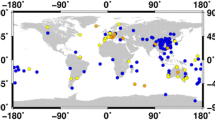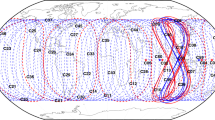Abstract
To validate the new system design and the new technology of the third-generation BDS (BeiDou-3), five non-GEO experimental satellites were launched during 2015 and 2016. In addition to the B1I and B3I signals that have been emitted by BeiDou-2, three newly designed civil signals (B1C, B2a, and B2b) were first transmitted by these satellites and are planned to be partly applied to the official BeiDou-3 satellites. In this study, the signature of elevation-dependent systematic biases in code measurements, which are commonly observed from BeiDou-2 satellites, was investigated for the three new civil signals based on observations collected using different types of receivers at different locations. Our results show that the RMS of multipath combination residuals of the new civil signal B1C was statistically larger than those of B2a and B2b signals. This indicates that B1C tends to be more seriously affected by multipath effects than B2a and B2b. Furthermore, the station elevation-dependent and satellite nadir- and azimuth-dependent multipath signatures were analyzed in detail. The results show that elevation-dependent variations in code measurements of B1I and B3I signals still exist for BeiDou-2 satellites, including the latest IGSO-6 (C13) launched in 2016. Based on different receivers which are equipped with all-in-view antennas, these types of code biases seem to be absent in the legacy B1C, B2a, and B2b frequency bands for BeiDou-3 in-orbit validation satellites. However, benefited from multipath-free conditions, results from a 40-m dish antenna reveal that the satellite-induced code pseudorange variations still exist in the bands of B1C, B2a, and B2b of BeiDou-3 in-orbit validation satellites, although their variation ranges are only at a level of approximately 0.1 m.










Similar content being viewed by others
References
Avila-Rodriguez J et al (2008) The MBOC modulation: the final touch to the Galileo frequency and signal plan. Navigation 55(1):15–28
Cai C, Gao Y, Pan L, Dai W (2014) An analysis on combined GPS/COMPASS data quality and its effect on single point positioning accuracy under different observing conditions. Adv Space Res 54(5):818–829. https://doi.org/10.1016/j.asr.2013.02.019
Chen J, Hu X, Tang C, Zhou S, Guo R, Pan J, Li R, Zhu L (2016) Orbit determination and time synchronization for new-generation Beidou satellites: preliminary results. Sci Sin Phys Mech Astron. https://doi.org/10.1360/SSPMA2016-00281 (in Chinese)
CSNO (2012) Report on the development of BeiDou Navigation Satellite System (version 2.1). Beijing
CSNO (2016) BeiDou Navigation Satellite System signal in space interface control document (Open Service Signal (Version 2.1)). Beijing
Hauschild A, Montenbruck O, Sleewaegen JM, Huisman L, Teunissen PJG (2012) Characterization of compass M-1 signals. GPS Solut 16(1):117–126. https://doi.org/10.1007/s10291-011-0210-3
Hein GW et al (2006) MBOC: the new optimized spreading modulation recommended for GALILEO L1 OS and GPS L1C. In: Proceedings of the IEEE/ION PLANS 2006, Institute of Navigation, San Diego, CA, 25–27 April, pp 883–892
Irsigler M, Eissfeller B (2003) Comparison of multipath mitigation techniques with consideration of future signal structures. In: Proceedings of ION GPS/GNSS 2003, Institute of Navigation, Portland, OR, 9–12 Sept, pp 2584–2592
Irsigler M, Hein GW, Eissfeller B (2004) Multipath performance analysis for future GNSS signals. In: Proceedings of ION NTM 2004, Institute of Navigation, San Diego, CA, 26–28 Jan, pp 225–238
Lei WY, Wu GC, Tao XX, Bian L, Wang XL (2017) BDS satellite-induced code multipath: mitigation and assessment in new-generation IOV satellites. Adv Space Res 60(12):2672–2679. https://doi.org/10.1016/j.asr.2017.05.022
Montenbruck O et al (2017) The Multi-GNSS Experiment (MGEX) of the International GNSS Service (IGS)—achievements, prospects and challenges. Adv Space Res 59(7):1671–1697. https://doi.org/10.1016/j.asr.2017.01.011
OS-SIS-ICD (2010) European GNSS (Galileo) Open Service—signal in space interface control document. Publications Office of the European Union
Rocken C, Meertens C (1992) UNAVCO receiver tests. UNAVCO Memo 8
SCIO (2016) China’s BeiDou Navigation Satellite System. Foreign Languages Press, Beijing
Shi C, Zhao QL, Hu ZG, Liu JN (2013) Precise relative positioning using real tracking data from COMPASS GEO and IGSO satellites. GPS Solut 17(1):103–119. https://doi.org/10.1007/s10291-012-0264-x
Simsky A (2006) Three’s the charm: triple-frequency combinations in future GNSS. Inside GNSS 1(5):38–41
Tan S, Zhou B, Guo S, Liu Z (2010) Studies of compass navigation signals design. Sci Sin Phys Mech Astron 40(5):514–519 (in Chinese)
Thoelert S, Meurer M, Erker S, Montenbruck O, Hauschild A, Fenton P (2012) A multi-technique approach for characterizing the SVN49 signal anomaly, part 2: chip shape analysis. GPS Solut 16(1):29–39. https://doi.org/10.1007/s10291-011-0204-1
US.DoD (2013) Global positioning systems directorate systems engineering & integration-interface specification IS-GPS-200 (IS-GPS-200H)
Wang GX, de Jong K, Zhao QL, Hu ZG, Guo J (2015) Multipath analysis of code measurements for BeiDou geostationary satellites. GPS Solut 19(1):129–139. https://doi.org/10.1007/s10291-014-0374-8
Wanninger L, Beer S (2015) BeiDou satellite-induced code pseudorange variations: diagnosis and therapy. GPS Solut 19(4):639–648. https://doi.org/10.1007/s10291-014-0423-3
Xie X, Geng T, Zhao Q, Liu J, Wang B (2017) Performance of BDS-3: measurement quality analysis, precise orbit and clock determination. Sensors 17(6):1233. https://doi.org/10.3390/s17061233
Xu G (2007) GPS: theory, algorithms, and applications. Springer, Berlin
Zhang X, He X, Liu W (2017a) Characteristics of systematic errors in the BDS Hatch–Melbourne–Wübbena combination and its influence on wide-lane ambiguity resolution. GPS Solut 21(1):265–277. https://doi.org/10.1007/s10291-016-0520-6
Zhang XH, Wu MK, Liu WK, Li XX, Yu S, Lu CX, Wickert J (2017b) Initial assessment of the COMPASS/BeiDou-3: new-generation navigation signals. J Geod 91(10):1225–1240. https://doi.org/10.1007/s00190-017-1020-3
Acknowledgements
This study was sponsored by National Natural Science Foundation of China (Nos. 41604029, 41574027, 41574030, and 61501430). The authors would like to thank the anonymous reviewers for their valuable comments and improvements to this manuscript.
Author information
Authors and Affiliations
Corresponding author
Rights and permissions
About this article
Cite this article
Zhou, R., Hu, Z., Zhao, Q. et al. Elevation-dependent pseudorange variation characteristics analysis for the new-generation BeiDou satellite navigation system. GPS Solut 22, 60 (2018). https://doi.org/10.1007/s10291-018-0726-x
Received:
Accepted:
Published:
DOI: https://doi.org/10.1007/s10291-018-0726-x




